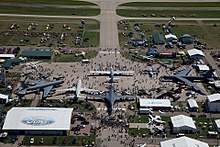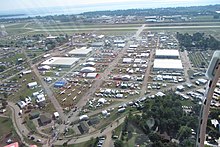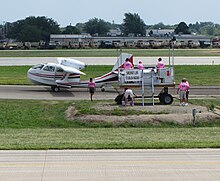EAA AirVenture Oshkosh

 Clash Royale CLAN TAG#URR8PPP
Clash Royale CLAN TAG#URR8PPP | AirVenture | |
|---|---|
 View of Boeing Plaza at EAA Airventure 2017 | |
| Status | Active |
| Genre | Air show |
| Dates | Typically the last week of July |
| Begins | July 22, 2019 (2019-07-22) |
| Ends | July 28, 2019 (2019-07-28) |
| Frequency | Annually |
| Venue | Wittman Regional Airport |
| Location(s) | Oshkosh/Nekimi, Wisconsin |
| Established | 1953 |
| Previous event | July 23–29, 2018 |
| Attendance | 601,000+ (2018)[1] |
| Activity | aerobatic displays, static displays |
| Organized by | Experimental Aircraft Association (EAA) |
| Website | https://www.eaa.org/en/airventure |
EAA AirVenture Oshkosh (formerly the EAA Annual Convention and Fly-In) is an annual gathering of aviation enthusiasts held each summer at Wittman Regional Airport (43°59′04″N 088°33′25″W / 43.98444°N 88.55694°W / 43.98444; -88.55694) in Oshkosh, Wisconsin, United States. The Southern part of the show grounds as well as Camp Scholler are located in the town of Nekimi.[2] The airshow is sponsored by the Experimental Aircraft Association (EAA), an international organization based in Oshkosh, and is the largest of its kind in the world.[3] The show lasts a week, usually beginning on the last Monday in July. During the gathering, the airport's control tower is the busiest in the world.[4]
Contents
1 History
1.1 Historical aircraft debuts
2 Attendance
3 Economic impact
4 Air-traffic operation
4.1 Technical operations
5 Volunteering
6 National Blue Beret
7 See also
8 References
9 External links
History

F-86 Sabre (top), A-10 Thunderbolt II (mid), and P-51D Mustang (bottom) performing at Oshkosh in 2009
EAA was founded in Hales Corners, Wisconsin in 1953 by Paul Poberezny, who originally started the organization in the basement of his home for builders and restorers of recreational aircraft.[5] Although homebuilding is still a large part of the organization's activities, it has grown to include almost every aspect of recreational aviation and aeronautics. The first EAA fly-in was held in September 1953 at what is now Timmerman Field as a small part of the Milwaukee Air Pageant, fewer than 150 people registered as visitors the first year and only a handful of airplanes attended the event. In 1959, the EAA fly-in grew too large for the Air Pageant and moved to Rockford, Illinois.[6] In 1970, when it outgrew its facilities at the Rockford airport, it moved to Oshkosh, Wisconsin.[7]
For many years the official name of the event was The EAA Annual Convention and Fly-In. In 1998, the name was changed to AirVenture Oshkosh,[8] but many regular attendees still call it as The Oshkosh Airshow or just Oshkosh. For many years, access to the flight line was restricted to EAA members. In 1997, the fee structure for the show was changed allowing all visitors access to the entire grounds.[9] EAA AirVenture holds nearly 1,000 forums and workshops.[8]
Historical aircraft debuts
AirVenture has been the aviation breeding ground throughout history for the debuts of numerous revolutionary designs. Richard VanGrunsven debuted his Van's RV-3 at the 1972 AirVenture Oshkosh, a homebuilt that defined new ways of aircraft performance. VanGrunsven would eventually go on to build more homebuilts than anyone else in the world, exceeding the annual production of all commercial general aviation companies combined.[10] In 1975, aircraft designer Burt Rutan introduced his VariEze canard aircraft at Oshkosh, pioneering the use of moldless glass-reinforced plastic construction in homebuilts, a technique that several aircraft went on to adopt in the ensuing years including composite commercial airliners.[11][12] At the 1987 AirVenture, Cirrus Aircraft's founders, the Klapmeier brothers, unveiled the Cirrus VK-30 kit aircraft,[13] which later led to the creation of the successful SR20 and SR22, the first designs to incorporate all-composite fiberglass construction, glass-panel cockpits and airframe ballistic parachutes for use in manufactured light aircraft.[12][14]
Other past notable designs introduced at AirVenture include Frank Christensen's Christen Eagle II aerobatic kit biplane in 1978,[12] Tom Hamilton's Glasair 1 in 1980,[15] and Lance Nebeur's Lancair 200 in 1985.[16]
Attendance

Commercial display at 2011 airshow

Aeroshell Aerobatic Team performing at EAA AirVenture 2007
The EAA estimated the attendance in 2018 at over 600,000, with 2,714 visitors registered from 87 nations. There were approximately 10,000 aircraft, 2,979 show planes, and 976 media representatives on-site from Six continents, along with 867 commercial exhibitors.[17]
In the past, attendance at the event was tabulated on daily basis rather than an individual basis.[18] It is unclear whether this practice still exists at EAA Airventure. For example, in 2006 the Oshkosh Northwestern reported that attendance was estimated at 625,000 by the EAA.[18] The estimate was for total attendees each day, so one person attending 7 days would count as 7 attendees. The paper estimated that between 200,000 and 300,000 individuals attended the event.[18]
The large number of aircraft arrivals and departures during the fly-in week makes the Wittman Field FAA control tower the busiest in the world for that week in number of movements.[19] To accommodate the huge flow of aircraft around the airport and the nearby airspace, a special NOTAM is published each year, choreographing the normal and emergency procedures to follow. More than 4,000 volunteers contribute approximately 250,000 hours before, during and after the event.[20]
Economic impact
The EAA AirVenture fly-in has a large economic impact to the Oshkosh area as well as the state of Wisconsin. In 1982, the Milwaukee Journal Sentinel reported that the fly-in had a large economic benefit to the Fox Valley region. At the time EAA estimated the benefit to be around $30 million ($76.1 million in today's terms) and the Oshkosh Convention and Tourism bureau estimated it to be lower, at $21 million ($53.3 million today).[21] In 1989, the Oshkosh Chamber of Commerce said that Winnebago county had a $47 million benefit from the fly in. Additionally, a 1987 UW-Oshkosh study reported a $65 million ($140 million in today's dollars) benefit to the entire state of Wisconsin.[22]
In 2008, a UW-Oshkosh Center for Community Partnerships study showed a $110 million economic impact for the Oshkosh area. Of that, $84 million was direct impact with a $26 million multiplier from secondary spending. Additionally, the fly in provided 1,700 jobs and $39 million in labor income for Winnebago, Outagamie and Fond du Lac counties.[23]
Air-traffic operation

FAA tower team in pink remotely managing departures

Control tower decorated with banner proclaiming "World's Busiest Control Tower"
In 1961, The Rockford EAA airshow had 10,000 aircraft movements.[24] In 1971, the EAA airshow at Oshkosh brought in 600 planes and 31,653 movements.[25] Today AirVenture brings in more than 10,000 airplanes. Special air traffic procedures are used to ensure safe, coordinated operations. For example, in 2014 the special flight procedures NOTAM was 32 pages long.[26]
FAA air traffic staff, including controllers, supervisors, and managers, compete throughout the FAA's 17-state Central Terminal Service Area to work the event. In 2008, 172 air traffic professionals representing 56 facilities volunteered to staff the facilities at Oshkosh (OSH), Fond du Lac (FLD), and Fisk. They wear bright pink shirts to stand out in the crowd.[27][28]
Due to the budget sequestration in 2013, the Federal Aviation Administration announced that it was not able to send resources to support the AirVenture. Rather than cancelling the event, the Experimental Aircraft Association was forced to sign a $447,000 contract to repay the government for FAA resources during the AirVenture.[29] EAA filed a petition in Federal court arguing that the FAA could not withhold services without specific Congressional action. However, in March 2014 EAA signed a settlement agreement agreeing to pay the 2013 costs and a further agreement that guaranteed FAA participation for another nine years. The agreement required the association to reimburse the government for AirVenture specific costs that had been provided at government expense in the years prior to 2013.[30]
Technical operations
Several days prior to the event, members of the FAA's Technical Operation team from around the Central Service Area arrive in Oshkosh to set up the temporary communication facilities (mobile communication platforms, FISK VFR approach control and Fond du Lac (FLD) tower). These technicians maintain the facilities during the event and tear down and store the equipment after AirVenture ends.[citation needed]
Volunteering
EAA AirVenture relies heavily on volunteers,[31][32] who arrive in the weeks leading up to the air show. The tasks they perform range from parking cars and airplanes, to painting buildings, to helping set up and tear down concerts and shows presented by the EAA. Long-time volunteers receive free meals, tee-shirts, embroidered patches, and free admission into the EAA AirVenture event.[33]
National Blue Beret
National Blue Beret (NBB) is a National Cadet Special Activity in the Civil Air Patrol. The event is two weeks long and is set up so that the second week will overlap with the AirVenture airshow. Participants are Civil Air Patrol cadet and senior members who must go through a competitive selection process in order to attend the event. Participants help conduct event operations, including flight marshaling, crowd control, and emergency services.
See also
- EAA Aviation Museum
- Steve Wittman
- Sun 'n Fun
- Tannkosh
- Tom Poberezny
- Young Eagles
References
^ "EAA AirVenture Oshkosh 2018 Facts and Figures".
^ "Town Of Nekimi Boundary Map". Retrieved 8 July 2018.
^ David Gustafson (2012). "Paul Poberezny's Three Great Accomplishments".
^ "EAA AirVenture takes flight for the future" Archived 2008-10-13 at the Wayback Machine., Milwaukee Journal Sentinel
^ "EAA Notable Dates and Milestones". Experimental Aircraft Association. Retrieved 2014-08-01.
^ "The Early Years". Experimental Aircraft Association. Retrieved 2014-08-01.
^ "Home in Oshkosh". Experimental Aircraft Association. Retrieved 2014-08-01.
^ ab "The World Comes to AirVenture". Experimental Aircraft Association. Retrieved 2014-08-01.
^ Jones, Meg (1997-07-27). "It's a bird; it's a plane; it's the Fly-In". Journal Sentinel. Milwaukee. Retrieved 2014-08-02.
^ EAA Aviation Center (n.d.). "1971 Van's RV-3". Retrieved 2015-02-26.
^ EAA Aviation Center (n.d.). "1975 Rutan VariEze Prototype – N7EZ". Retrieved 2015-02-26.
^ abc Gustafson, David. "Tom Poberezny and the Maturing of EAA". Retrieved 2015-02-26.
^ EAA Aviation Center (n.d.). "Cirrus Design Corporation VK-30 – N33VK". Retrieved 2015-02-26.
^ Gustafson, David. "Robert Goyer, Editor of Flying Magazine, Talks Homebuilding". Retrieved 2015-02-26.
^ EAA Aviation Center (n.d.). "1979 Stoddard-Hamilton Glasair 'Ham2'". Retrieved 2015-02-26.
^ EAA Aviation Center (n.d.). "1984 Neibauer Lancer – Lanair 200 – N384L". Retrieved 2015-02-26.
^ Experimental Aircraft Association. "Overview". www.eaa.org. Retrieved 2018-07-31.
^ abc Zellmer, Doug (2006-08-02). "AirVenture attendance drops". Oshkosh Northwestern. Archived from the original on 2006-08-22. Retrieved 2014-07-31.
^ Meg Jones (2004-07-24). "EAA AirVenture takes flight for the future". Milwaukee Journal Sentinel. Archived from the original on 2008-10-13.
^ "EAA Airventure Facts" (PDF) (Press release). Experimental Aircraft Association. Archived from the original (PDF) on 2007-01-17.
^ "Fly-in has large impact on economy of region". Journal Sentinel. Milwaukee, WI. 1982-08-03. Retrieved 2014-07-31.
^ Savage, Mark (1989-08-01). "Fly-in gives area economies a big lift". Journal Sentinel. Milwaukee, WI. Retrieved 2014-08-01.
^ Jones, Meg (2008-12-24). "EAA is huge boon to state". Journal Sentinel. Milwaukee, WI. Retrieved 2014-07-31.
^ "EAA FLY-IN". Flying Magazine. December 1961.
^ Air Trails: 4. Winter 1971. Missing or empty|title=(help)
^ "2014 Oshkosh NOTAM" (PDF). Retrieved 2014-07-30.
^ "The Show Begins at AirVenture Oshkosh". July 28, 2008. Retrieved 2014-07-30.
^ "2014 Oshkosh NOTAM" (PDF). p. 14. Retrieved 2014-07-30.
^ Namowitz, Dan (June 11, 2013). "EAA agrees to pay FAA to save AirVenture, amid outrage". Retrieved 2014-07-30.
^ "EAA, FAA Reach Agreement on AirVenture ATC Costs". Experimental Aircraft Association. Retrieved 2014-07-30.
^ "Be an EAA AirVenture Volunteer". Archived from the original on 2010-12-12. Retrieved December 23, 2010.
^ "Be an AirVenture Insider: Volunteer". Archived from the original on 2010-12-12. Retrieved December 23, 2010.
^ "Campers, Volunteers All Set up for EAA AirVenture". The Kathryn Report (Blog). July 2, 2010. Retrieved December 23, 2010. [unreliable source?]
External links
| Wikimedia Commons has media related to EAA AirVenture Oshkosh. |
- EAA AirVenture Oshkosh
- Experimental Aircraft Association